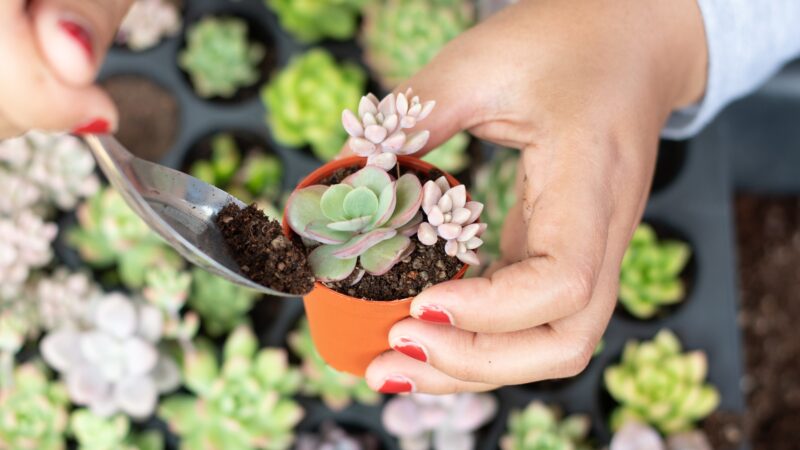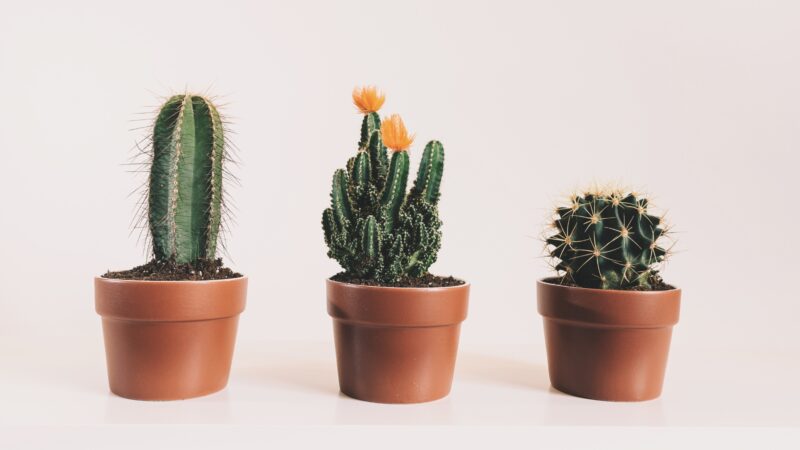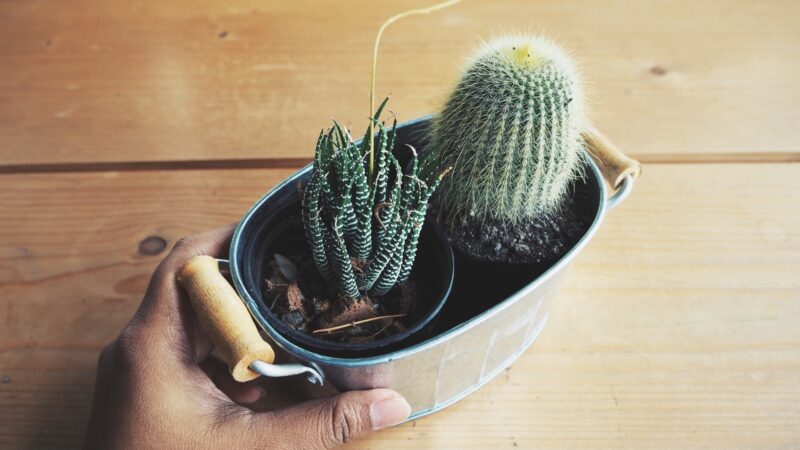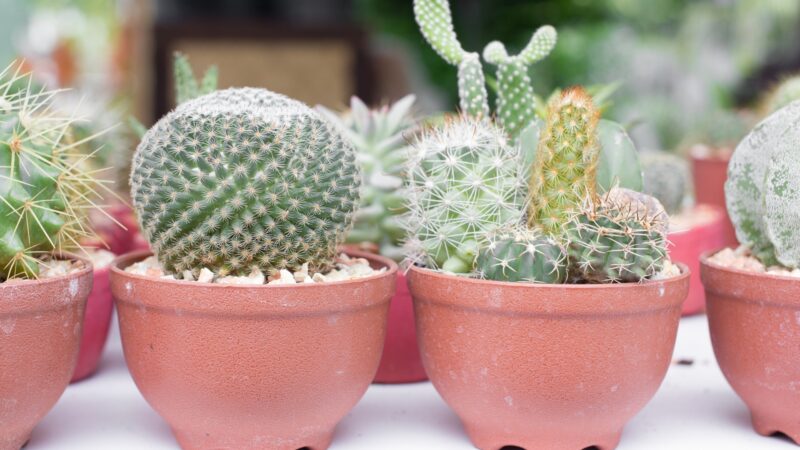Cactuses are among the most popular indoor plants out there. Considering their hardy nature and low-maintenance characteristics, cactuses are the first choice among new gardeners.
Aside from being easy to care for, cactuses are also easy to propagate. This means that you can grow more cactuses using the ones you already have at home.
With that in mind, how exactly do you propagate a cactus? There are five ways to propagate a cactus, and these are:
- Propagation from cuttings.
- Propagation from a pad.
- Propagation from the offset.
- Propagation from the seeds.
- Propagation by grafting.
In this article, you’ll learn all about propagating a cactus using the five methods enumerated above. You’ll be guided through a step-by-step procedure for each method, so you don’t have to worry about making a wrong move.
What Is Cactus Propagation?

Cactus propagation refers to the procedure of producing new cactus from parts of an existing cactus, otherwise known as the mother plant.
The process involves taking a part of a live and healthy cactus and planting it for it to grow its independent root system. For cactuses, propagation may be made through their seeds, offsets, cuttings, pad, or by grafting.
Of the methods by which you can propagate a cactus, the easiest to grow are the offsets, cuttings, and pads. Because they once formed part of a healthy cactus, growing its roots may take a shorter time than with seeds and grafting.
Thus, if you want to grow your new cactus within a few weeks or a month, then these are your best options.
When to Propagate a Cactus Plant?

The best time to propagate a cactus is during its active season, which is around late spring and summer. During this time, the temperature and humidity are ideal for a cactus’s growth.
Bear in mind that cactuses prefer a temperature of around 60 to 90 degrees Fahrenheit and humidity levels of above 40 percent. When a cactus is propagated considering these conditions, there is a higher chance of success and growth.
When Not to Propagate a Cactus Plant?

Considering the discussion above, it is not advised to propagate a cactus when it’s cold and the air is dry. This includes the autumn and winter seasons when the temperatures usually drop to freezing numbers.
If a cactus is propagated during these seasons, there is a small chance for it to survive, especially since it is considered its dormant season.
Additionally, it is not advised to propagate a cactus during a heat wave. While cactuses love warm temperatures, a heat wave may cause them to dry up.
During a heat wave, cactuses may feel stressed out because they’re trying too hard to survive. Thus, the plant part you’re trying to propagate may not grow at all during a heat wave.
5 Ways to Propagate a Cactus | Step by Step Guide
How to Propagate Cactus From Cuttings?
Perhaps the most popular way to propagate cactus is from its cuttings. Through this method, you will be taking a portion from your cactus and planting it to grow into a new cactus.
Step 1: Before you begin, it’s important to choose which part of the cactus you want to propagate. As much as possible, choose a healthy stem or leaf part for this method. Cut your desired part and make sure it’s not shorter than four inches long.
Step 2: Once you have separated your cutting, it is advised to wait for two to three days before putting it into a pot. However, if your cutting is quite thick, you can wait a few more days until it looks dry enough for planting. You will know if it is dry enough if there is browning from the part where it was cut, as well as wrinkling in its outer perimeter.
Step 3: The next step is to fill your pot with soil or soil mix. The ideal soil for cactuses is well-draining, like the All Natural Succulent and Cactus Soil Mix. Fill the pot with about 3.5 inches of soil.
- 🌻 FRESH, ORGANIC — This Specially Formulated Succulent Soil...
- 🔎 PROFESSIONALLY MIXED — From the Growers at Perfect Plants...
- 💦 WATER MANAGEMENT — This Succulent Soil Mix Drains the...
- 💙 MIX INCLUDES — Garden Coir, Composted Pine Bark, Perlite,...
- ✅ EASY ZIP, RESEALABLE BAG — Perfect for Keeping your Mix...
Step 4: Then, insert the cutting with the base at the bottom. Make sure there’s around an inch of soil between the pot and the base of the cutting.
Step 5: Then, lightly mist the soil with water and place the pot somewhere where the cutting can receive indirect sunlight. As much as possible, only mist your new plant whenever the soil feels dry to the touch.
That’s it. Within a few weeks, the cutting will start to grow new roots and become an independent plant.
How to Propagate Cactus From a Pad?
Aside from cuttings, you can also propagate a cactus from its pads. These pads are the flat oval-shaped leaves growing from cactuses. Fortunately, it’s easy to grow roots on a healthy cactus pad.
Step 1: Choose the cactus pad you want to propagate. As much as possible, the pad should not have any visible damage or sign of discoloration. Otherwise, it may either take a while to grow or prevent its successful propagation.
Step 2: While wearing a pair of garden gloves like the OIZEN Leather Tough Cowhide Work Gardening Gloves, gently twist the pads off of the mother cactus. Alternatively, you may use a disinfected knife or cutter to separate pads.
- Crafted for Durability: This gardening glove is made of carefully...
- Ergonomics Design: Stretchable double-layer spandex back keep...
- Touch Screen Friendly: The unique and practical 2 touchscreen...
- Size and Fit: This gardening glove is available from Size S to L....
- Multipurpose: Suitable for all kinds of gardening work, daily...
Step 3: Once removed, it is advised to wait a day or two before planting the cactus pad into the soil.
Step 4: Once the cactus pad is dry and ready for planting, simply fill the pot with soil. Insert the pads into the soil for about an inch deep. Then, mist the soil with water until it feels moist.
Step 5: While waiting for the roots to grow, simply place the plant in an area in your home where it gets a good amount of indirect sunlight. Then, water it whenever the top layer of soil feels dry.
How to Propagate Cactus From the Offset?
Another way to propagate cactus is from its offsets. Otherwise known as pups, these refer to the tiny growths on a cactus that often look like a miniature version of the mother cactus. Here is how you can propagate using cactus offsets.
Step 1: From your cactuses, choose the one with the most pups or offsets. This is a way to determine how healthy the cactus is and that the offset will surely propagate.
Step 2: While wearing your gloves, gently twist the offset away from the mother plant. For best results, pick the pup that’s at least an inch tall already.
Step 3: Then, plant the pup or offset into the soil. Make sure to have about half of the pup planted under the soil.
Step 4: The next step is to lightly mist the soil with water to help it grow its roots. Then, keep the planted offset in a shaded area in your home while you wait for the roots to grow.
How to Propagate Cactus From Seeds?
You can also propagate from cactus seeds. However, this will only be possible if your cactus is mature enough to produce cactus pods. Depending on the cactus subspecies, these pods refer to the colorful elongated growths on your cactus. These contain seeds that you can use to grow a new cactus from.
Step 1: To start propagating cactus from its seeds, you first need to pick the seeds from the pods. With your hand or a clean pair of tweezers like these QTTECH Tweezers, you can pluck the seed pods from the cactus.
- 2 Pcs 11 Inch Black Long Handle Stainless Steel Straight and...
- The tip tweezers are perfect for cooking, roasting, grabbing...
- HIGH-QUALITY MULTIPURPOSE Chef's Large TWEEZERS Long Our culinary...
- IMPRESSED ACCURACY: The cooking tweezers set have precision...
- HEAVY DUTY STAINLESS STEEL MATERIAL - Our kitchen tweezers are...
Step 2: After picking the pods, simply open them and collect the seeds. If the pods are dry, simply collect the seeds in a tiny cup or container you have at home. However, if the pod still contains pulp after opening, simply wipe the pulp and the seeds onto a clean piece of tissue paper and wait for it to dry overnight.
Step 3: Now that you have collected dry seeds, you can now spread them over the soil. The more seeds that you have, the higher the chance that you will have at least one cactus that will reach maturity. Then, mist the soil and seeds with water.
Step 4: While waiting for the seeds to germinate, simply place the pot in an area that gets a good amount of indirect sunlight to promote the cactus’s healthy growth.
Step 5: Mist the soil as needed, especially when the top layer already feels dry.
If your cactus has not yet grown seed pods, you can also use store-bought cactus seeds and follow steps 3 to 5.
Also, bear in mind that propagation from seeds may take longer than propagation from cuttings, cactus pads, or offsets since you’ll be growing your cactus from scratch.
How to Propagate Cactus by Grafting?
If you’ve seen two seemingly different cacti merged into one plant unit, then you already have an idea of what grafting is. It is the process of merging a top cactus or scion onto a green cactus bottom or rootstock. If you’re curious about the process, here is how you can successfully propagate by grafting:
Step 1: The first step is to pick the ideal rootstock for your scion. Since the rootstock forms the lower part of the new plant with its roots still attached to the soil, it must be continually growing. It should be hardy enough to withstand changes in temperature, water fluctuations, and other conditions. Also, it should be healthy and big enough to carry the scion.
Step 2: Once you have picked your rootstock, gently cut off its head, with about two or three inches above the soil remaining.
Step 3: Then, pick your scion or top cactus. Usually, this is a cactus variety that is not healthy or has underdeveloped roots. This way, it can benefit from the organic matter coming from the rootstock.
Step 4: Once you have chosen which scion to use, gently cut off its head.
Step 5: Now, simply place the scion on top of the rootstock and secure the pieces together with a plastic strip that’s fastened with a rubber band.
Step 6: Then, water the rootstock as usual.
Step 7: After a week, you can now remove the rubber band and plastic since the scion and rootstock have already merged. Continue to water as usual and give them the right amount of sunlight to ensure a successful propagation.
When cutting off the rootstock and scion, make sure that your garden knife is properly sterilized. Otherwise, you might introduce bacteria onto the grafted parts, which could lead to a disease or infection.
What Is the Fastest Way to Root a Cactus?

Depending on how you take care of your separated plant part, it will grow its independent root system within four to eight weeks. The speed by which it grows may also depend on the cactus sub-species, the cactus part used in propagation, and the environmental conditions present during its propagation.
With that said, the fastest way to root a cactus is if you propagate from a cutting during the late spring and summer months. As long as it is planted under ideal circumstances – with compact soil and a well-draining pot – you can expect the root system to grow within four weeks.
How to Root a Broken Piece of Cactus?
It’s always disheartening to find broken pieces of cactus. Fortunately, there is hope for these cactus parts, so they should not be discarded at once.
Despite being broken, this cactus piece is capable of growing its root system if planted. Fortunately, the process for rooting a broken piece of cactus is similar to propagating from cuttings.
To root a broken piece of cactus, you simply plant the broken piece on the soil, soak it in water, and wait. Within a few days, the wound will start to heal. And within a few weeks, it will grow its roots.
However, for best results, make sure that the broken cactus piece is even. If it is not even, then slice off a small part of it until it looks even.
Additionally, if the broken piece seems big enough to produce multiple cuttings, then it is also advised to slice them into several pieces. This way, you can produce a couple of new cactuses from a single broken piece.


